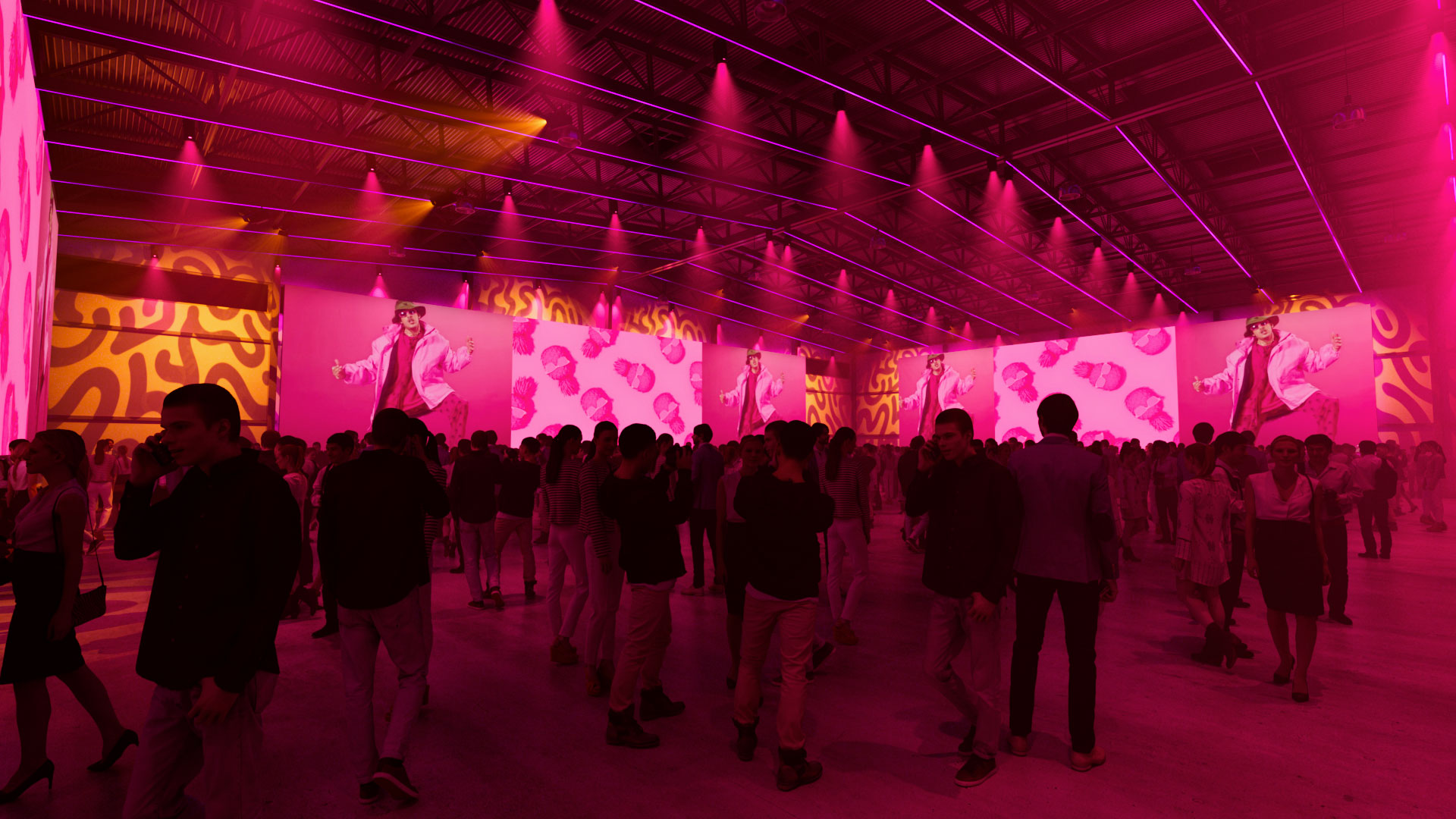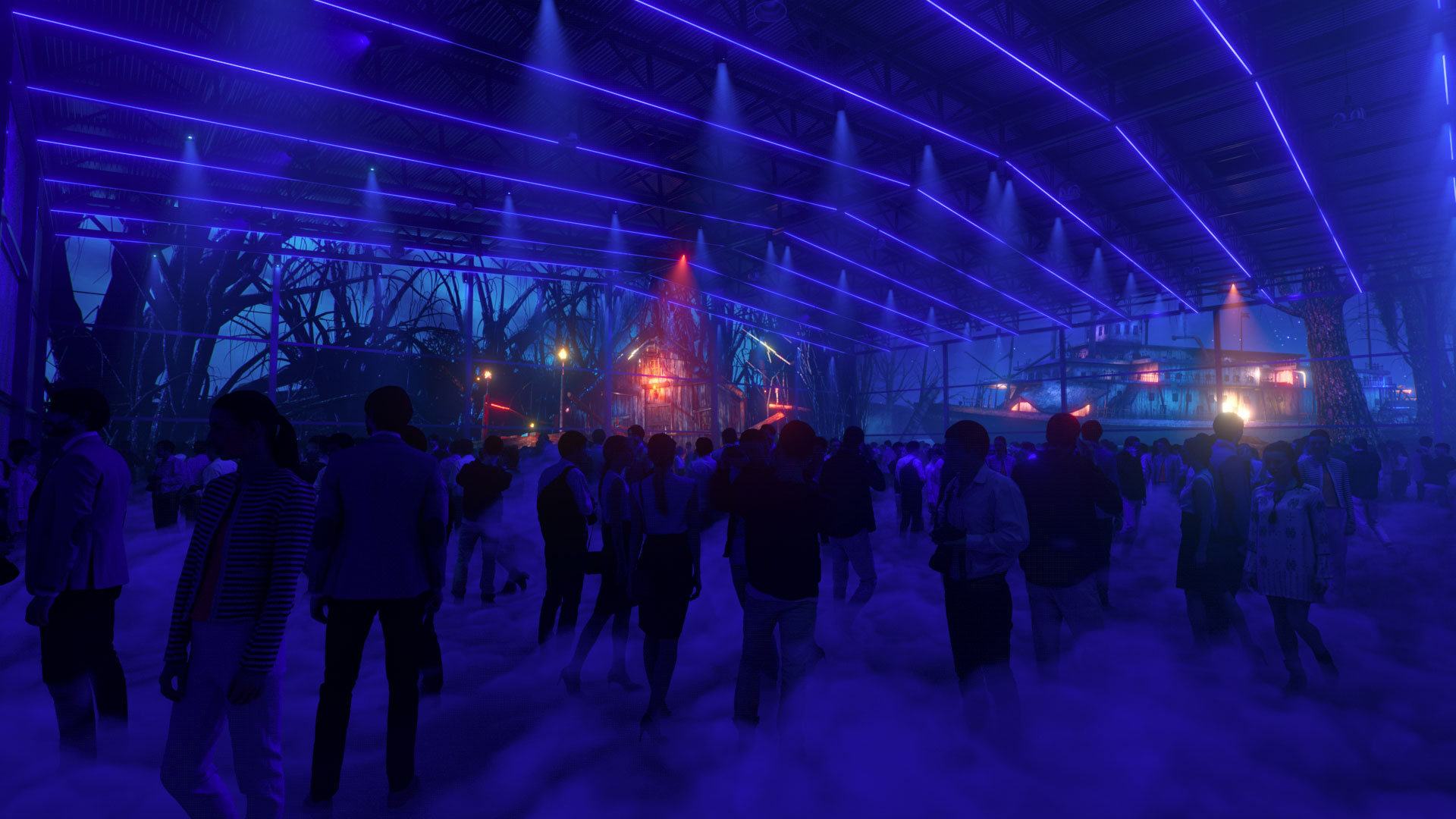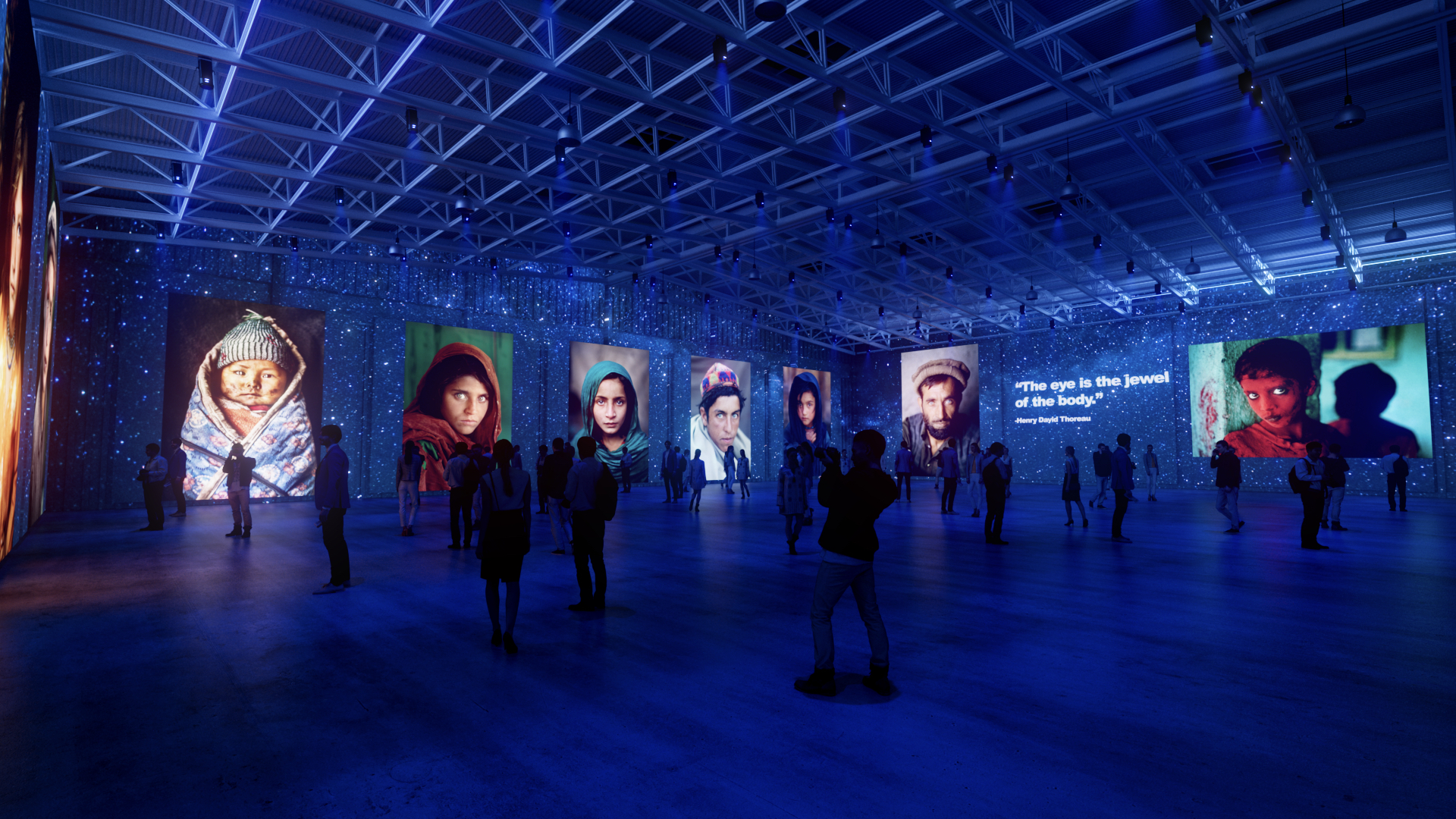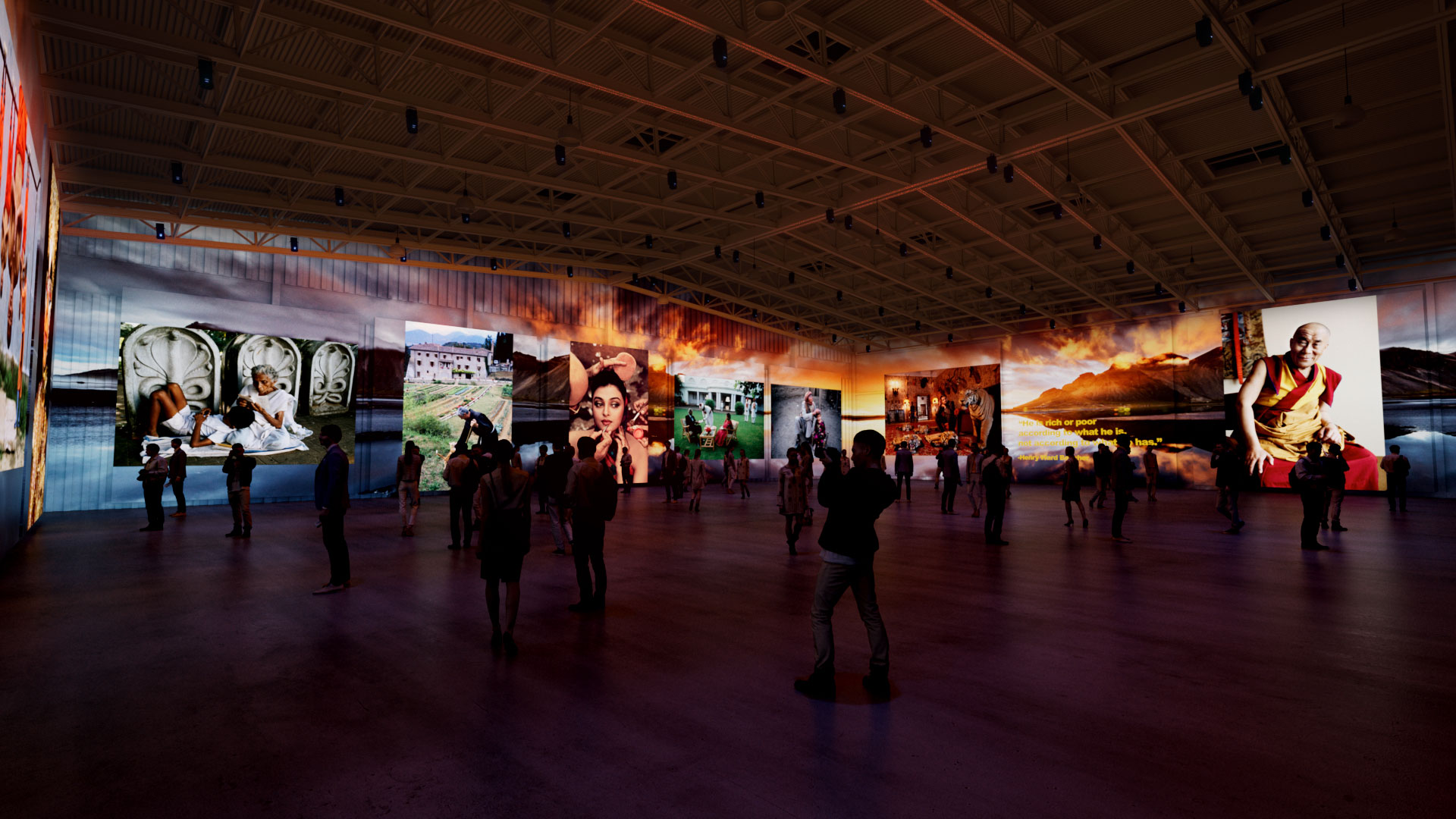
Welcome to Entertainment Experience Evolution 2023
Robb Wagner’s Experiential Transformation Bulletin
Greetings attendees! To get your EEE juices flowing, I have compiled this collection of creative concepts, articles and blogs. BTW — Experiential Transformation means taking your brand’s existing assets and transforming them into something that people have simply never experienced before. I’m looking forward to connecting with you in LA.

Robb Wagner
Concepts

A restaurant becomes hyper-reality


A space becomes transformative


A bar becomes animated


A box becomes an immersive experience

What could your shopping center become?

Robb Wagner
Founder, Stimulated-Inc.
Robb Wagner has spent his career helping to hyper-transform experiences for such globally recognized brands as Disney, Viacom, Carnival Cruise Line and YouTube. At the core of his success is a radical approach to work and passion for disruption.
As CEO of Stimulated-Inc. – the creative studio he founded in 2005 – Wagner spearheads high-level creative solutions that he translates across industries. From television and film to streamed video, concerts and other live performances, he has been able to borrow principles from one sector and apply them to the next, tapping an often-counterintuitive approach and core mindset shifts as part of the process.
Wagner, for example, prefers to start projects with the outcome, reverse-engineering the work to accomplish his goals. Developing his own creative methodology and workflow solutions in 2012, Wagner future-proofed his company while giving his team a seamless way to scale creative production for seven-figure projects.
As a result, his creative breakthroughs have raised the bar on big and small screens, with each successful brand experience benefitting from the last. A few such large-scale examples include developing content for 50 video screens at the MTV Video Music Awards, producing larger-than-life 3D visuals for Michael Jackson’s This Is It concert tour and film, and creating digital content in front of a live audience at the first-ever YouTube Music Awards, alongside Spike Jonze.
Wagner, a member of the Directors Guild of America, lives in the surfside town of Hermosa Beach, California with his wife and business partner, Pam.
Why shopping centers need to take a counterintuitive approach to experiential transformation

By Robb Wagner — July, 2022
As shopping center developers, operators and marketers try to figure out their experiential futures, part of the conversation will inevitably be about technology. What the industry’s movers and shakers will need to keep in mind as they chart their course is that when it comes to experience, technology is most often a what and sometimes a how, but rarely a why.
Here’s the reason focusing on technology rather than experience can be a problem for shopping centers.
The social media giant now known as Meta (Facebook) purchased VR company Oculus for $2B in 2014, and has since thrown its bottomless marketing resources and money behind it. But the technology has failed to create mass consumer interest to date.
When it comes to creating popular consumer experiences, you can’t always start with the technology. As business thought leader Simon Sinek advises, “Start with why.”
Why is this important for shopping centers? Because I believe they are entering a period of experiential transformation that will shape their next 10 years—and this is a proven formula that can help them succeed.
As shopping centers shop for solutions to increase engagement, visits and dwell time, technology companies will line up to sell them solutions with the promise of making people want to flock to their centers.
But, it won’t actually work that easily. Just ask the heavily funded augmented reality startup, Magic Leap. Like Facebook’s Oculus, it is another technology with incredible potential and significant financial investment that hasn’t found its purpose after more than 7 years of trying.
Billions of dollars have been invested in these technologies with little measurable ROI to date.
Shopping centers can’t afford to follow this approach because they don’t have infinite marketing budgets and 7 years to waste. There is however something they can do.
Follow this proven formula:
- Start with the outcome.
- Develop radical creative ideas to help achieve them.
- Identify the technologies you need.
- Create emotional content.
- Deliver the experience.
This approach has helped companies in nearly every major entertainment genre create success over the past 16 years, including broadcast, concerts, film, live entertainment, digital entertainment and cruise lines.
It started it 2004, when I was working with MTV to help transform broadcasts like the Video Music Awards, with the addition of more than 50 LED screens in a 360 degree arena. My job was to work with the network, the production and the musical artists to develop and deliver content to larger-than-life video screens. I didn’t focus on how we were going to do it. I focused on the outcome we wanted to create.
Many of my broadcast peers saw LED screens as a place for eye candy, and pushed to start with technologies that delivered canned footage to the screens. The word ‘gak’, was widely used behind the scenes in broadcast as a term for screen content, which I detested.
While they did that, I imagined using LED screens for narrative storytelling and emotional connection. I envisioned musical performances being more powerful, memorable and emotional for the audience, and more valuable to MTV and the artists.
What would create more of an emotional connection with music fans? Animated clip-art and stock footage in the video screens, or mind-blowing three story high versions of their musical heroes in an experience the fans were immersed in?
To push my radical vision onto a resistant industry, I had to be a disruptor. In 2005, I launched my creative studio and branded it as the antidote to mundane cut and paste content. We developed radical creative ideas with our clientele, found or developed the technologies we needed to implement them and developed content that ultimately became part of an experience that stirred audience emotions and generated revenue.
For 16 years, this counterintuitive approach has helped create breakthrough success for some of the world’s biggest and best entertainment companies including Viacom, Disney and Sony. Today, it is helping the world’s largest cruise line develop and implement innovative entertainment experiences that stimulate emotional connections with guests, along with customer loyalty and all-time-high customer satisfaction.
As shopping centers try to figure out their experiential futures, the people that develop, operate and market them will need to learn and master this backwards approach. They will need to remind themselves that the experience is the innovation. It is the catalyst for emotional connection and business success.
Steve Jobs said it best: “You have to start with the customer experience and work backward to the technology.”
To sum it up, if shopping centers work backwards to create their experiential futures, I’m betting they’ll be able to take it to the bank for years to come.

What shopping center operators can learn from the decline of one industry and the rise of another.

By Robb Wagner — May, 2022
I got my start in experiential entertainment nearly 20 years ago working as a creative producer for live-broadcast specials like the MTV Video Music Awards and MTV Movie Awards. After the Great Recession, and with the broadcast industry embracing change about as slowly as a sloth wearing ankle weights, I seized the opportunity to ‘jump ship’ and help other industries develop their own experiential entertainment futures. One such industry was cruise lines.
Back in 2009, cruise lines had been devastated by a global paradigm shift (the Great Recession) and needed new ways to monetize their big existing investments. With competition for audience share steadily increasing, they also recognized the urgency in making new investments in experiential transformation.
This was a sink-or-swim situation, and the cruise lines chose to swim… or rather to keep floating and transform the experience that began when guests stepped aboard their ships. They knew this transformation meant making investments into entertainment infrastructure with a broader vision that required outside help.
In 2010, I was among a group of external creative partners headhunted by a consulting firm for the world’s largest cruise line. Coming from the broadcast industry, where most important decisions seemed to be intuition-based, I was impressed when I learned they were using actual data to understand their future customers.
Over the ensuing years, I worked in the industry to help develop and reinvent its entertainment experience, incorporating some of the radical transformations that helped cruise lines become entertainment leaders in their own right. I was in the eye of the storm, witnessing a decade of growth in the cruise line industry that led up to the COVID-19 pandemic.
In the midst of it all, I also happened to visit a former high-level television colleague in her luxury Times Square office suite. When I talked about some of the innovative entertainment we were developing around cruise line audiences, she sighed.
“Wow, Robb. You can’t imagine how frustrating it is for me to be part of a big, slow-moving industry, where executives still think they know what people want, then order a pilot or presentation, show it to a focus group, and spend millions of dollars only to see the project fail. And then they wonder why.”
“Actually, I can,” I told her, recalling a conversation I’d had with another television executive whose network called me asking for help developing an entertainment show starring avatars. When I asked how the network knew their audience wanted a show starring avatars, he told me they didn’t know. I was told a decision-maker would greenlight this multi-million dollar project based on gut feelings. I didn’t accept the job. Not surprisingly, and very unfortunately, the avatar project failed.
This was just one of the many examples underscoring the broadcast industry’s systemic failure to adapt quickly and innovate based on real data, whereas the cruise line industry, on the other hand, took post-recession transformation seriously with investments in experiential transformation that are still paying off today.
The big cruise companies analyzed the needs of their future audiences and used that intel to develop and implement new entertainment concepts. Nearly 12 years later, emerging from the pandemic, they also continue to analyze and keep transforming their entertainment experiences around audience wants and needs.
What does any of this have to do with the future of retail? A lot. Hear me out.
Commercial property owners, who were already suffering well before the pandemic plunged shopping center real estate values by some 60% in 2020, are now in a very similar position to the one shared by the cruise line industry after the Great Recession:
- Big existing investments they need to monetize
- Steadily increasing competition for audience share
- Need to make new investments & transform
Let’s face it. At a time when consumers can get same or next-day deliveries of practically anything they want by merely touching their phones, shopping centers have got to do a hell of a lot more to draw and retain physical traffic. They need to offer entertainment experiences powerful enough to lure people in and make the outside world cease to exist the moment people step inside. They need to make customers feel as if they are not merely entering a place to go shopping, but are actually embarking on an entirely new world of unique and memorable experiences to share with their friends and family.
Shopping centers are in a position to deliver live and digital experiences, and provide extra layers of entertainment that consumers can’t find anywhere else. Video content can help create a more complete experience to keep customers engaged. Constant innovation of entertainment experiences both inside and outside of stores can provide something completely new and exciting for guests. If done well, this can trigger dopamine and leave customers wanting more.
The rabbit in the hat for shopping centers is their accessibility. Not everyone can book a week-long cruise to the Caribbean, but Americans can easily spend days or evenings out at the shopping center, especially if they’re offered something people have never experienced before.
Shopping centers have inherent magic that is begging to be built upon. They have the ability to transform and become entertainment leaders, providing the experience that today’s (and ideally tomorrow’s) consumers crave. But they need to make a radical shift in the customer experience they deliver.
Borrowing a cue from the cruise line industry, which is now entering a period of explosive, post-pandemic growth, shopping centers can transform the typical mall trip into a completely unique entertainment experience that gives people more reason to leave their homes.
If they take post-pandemic transformation seriously and invest in their experiential entertainment future the way that cruise lines did—I predict a retail riot. The good kind of riot.
Pre-Pandemic Blog
Hyper-Transforming Retail
Using Experiential Transformation to Save America’s Brick and Mortar Stores and Malls
By Robb Wagner — September, 2019
Every moment of crisis is an opportunity. When a threat arises in the primal world, we have two choices: Fight or Flight. But smart C-suite leaders know that in business, there’s a third option: Fight, Flight or Transform. Transformation is how companies like Netflix and IBM continue to remain relevant in a rapidly changing consumer landscape. Transformation is how Play-Doh went from being a 1930’s wall cleaner to one of Hasbro’s top-performing toy products.
And transformation is how America’s brick and mortar stores can go from barely-surviving to traffic-driving in the next five years.
What analysts are now calling the Retail Apocalypse has been a topic of much speculation. Thanks to a perfect storm of factors — the Great Recession, a digitally-inspired exodus from brick-and-mortar shopping, changing cultural attitudes and values — it is estimated that 75,000 stores will close by 2026.
But not all retail stores are struggling. Some are even gaining market share,. To be among the profitable few, retailers need to take an honest look at their own purpose and the consumer needs they meet. It is only in examining the past and taking stock of the present that we can write the future.
The very first mall… wasn’t. As far back as the eighteenth century, the word “mall” meant a “shaded walk serving as a promenade.” This definition would serve it well until 1954, when architect Victor Gruen debuted what is considered America’s first modern indoor shopping mall in Edina, Minnesota. He called it a “mall” because it was modeled after the fountain-filled promenades and gathering spaces of his youth in Vienna, Austria. In response to growing post-war suburban sprawl in the U.S., Gruen had envisioned a purposeful “third place” where Americans could spend quality time in peace, away from traffic and smog. And virtually every shopping mall built since has been modeled after that first creation.
But here’s where this history lesson gets really relevant: the inventor of the Great American Shopping Mall meant for it to be about so much more than shopping. Gruen originally envisioned malls as mixed-use facilities that could address environmental, commercial and sociological problems. He imagined them as true mixed-use spaces, filled with shops, apartments, offices, medical centers, child-care facilities, libraries and bomb shelters (it was the fifties, after all).
Although the consumer-driven, retail-heavy model Americans got instead was ultimately a success for several decades, it’s now time for the industry to do some serious soul-searching.
How to survive: reinvent or revive?
One effort to save shopping malls realigns with Gruen’s original intent. “You’ll find DMVs, town halls, and libraries in malls increasingly… Main Street was killed by the mall, so developers are trying to build new downtowns inside the malls,” explains June Williamson, author of “Retrofitting Suburbia.”
The average shopper used to spend hours in a mall, but today they spend less than an hour. Housing non-retail services is one way to lure consumers back into malls and keep them there. But is it really an effective tool to promote retail sales? After being held captive in a line for twenty minutes waiting on your Driver’s License renewal, how inspired do you feel to buy a new outfit?
Savvy developers have realized that in order to create a successful retail environment, entertainment must be built-in. According to Richard Florida, author of The New Urban Crisis, “…the stores that are drawing in customers are those that emphasize experiences.”
One case in point is The Grove in Los Angeles, an outdoor shopping mall complete with a mini main street, retro-style trolley, dancing fountain and Summer concert series. You could say it’s been a success — the center sees more visitors per day than Disneyland. Another is American Dream in New Jersey, an upcoming three million square foot center that boasts a ratio of 55% entertainment to 45% retail. When completed, it will house a ski run, DreamWorks water park, Nickelodeon Universe theme park, Legoland Discovery Center, ice-skating rink, Ferris wheel and indoor garden,.
According to Uma Karmarkar, a neuro-economist at University of California San Diego, these types of fun activities attach a brand memory to a positive experience, potentially giving the same type of adrenaline-rush that happens when one makes a purchase16. But does all that adrenaline lead to actual retail purchases? The Walt Disney Company’s financial statements say that it does. Their theme park retail sales continue to drive significant revenue growth at a time when America’s overall retail purchases see only minor gains.
But here’s the thing. You don’t need to build a theme park to generate more store traffic. Here are 5 ways you can use the power of experiential transformation to enhance your environment and boost revenue.
1. Become an entertainment leader.
Marketing expert Sally Hogshead puts it bluntly: “Different is better than better.” As more online and offline experiences compete for a slice of consumers’ attention, retailers need to continually innovate in order to stay relevant. Cruise lines, in a parallel industry you could call the “mall of travel,” have seen steady growth, thanks to their agenda of relentless innovation. Take a cue from their playbook and invest in a flexible entertainment infrastructure that includes LED screens and convertible spaces in order to deliver fresh entertainment that keeps shoppers coming back for new experiences.
2. Reinvent usefulness.
The best business innovators solve a problem. For shopping malls losing sales to online retailers that are perceived to offer lower prices, solving consumers’ budget-woes and unemployment issues could offer a surprisingly synergistic fit. Housing co-working spaces and job training centers is one way to support and build your customer base, but replacing retail tenants with corporate ones isn’t the only option. Hosting one-off seminars, immersive tech training experiences, job fairs and networking events is another. At a minimum, boosting your work-friendly infrastructure (wi-fi, laptop lounge spaces, 360o teleconferencing rooms and caffeinated food court options) will help attract mobile workers and business travelers to your facility.
3. Be Share-worthy.
Create experiences that are meant to be seen, heard, felt & shared. At Stimulated-Inc., we call these Ultra-Sensory Experiences™. Selfies and online sharing aren’t going anywhere, and full-fledged Insta-destinations are now being built around them. Installing a few wall graphics isn’t a sustainable way to garner repeat visits, but it does provide a clue about where to start. Today’s shoppers are inherently visual. But to create an ongoing share-worthy relationship with them, your installation should be both flexible and emotional.
According to a recent Deloitte report, “In an industry shifting toward experience-based models, retailers should look to make emotional connections, not just transactional ones.” For CEOs and CTOs, delving into the world of “feelings” can seem like shaky ground. That’s why it’s imperative that you work with partners well-versed in the language of storytelling and emotion.
4. Inspire activity.
In the middle of what many consider to be a public health crisis, malls could offer a unique solution for the nearly two thirds of America’s population that is overweight. Mall fitness, in the form of “mall walking” isn’t new. But creating transformative, virtual in-mall experiences where guests could spin through through the backroads roads of Europe, meditate in Crater Lake National Park or dance at a pop concert could incentivize healthy activity and draw more consumers to shopping centers.
5. Welcome Families.
Most children’s areas are superficially-updated versions of generations-old playground designs. And they are no match for today’s handheld devices. But opportunities abound for creating original, twenty first century family-friendly IP that can attract and sustain repeat visits. Imagine a character on screen that is able to speak directly to a young mall visitor in real time. This illusion erases the line between fantasy and reality, and is achieved by a live actor who controls the character remotely. This is just one example of how shopping malls could leverage technology and storytelling to implement a uniquely engaging experience.
The bottom line is that in order to redefine themselves, retailers need to throw away the blueprints of the past — and the present. Although it might feel reassuring to cut and paste what’s working for other malls and stores, this much is certain: your content must be 100% original and relevant in order to succeed. What drives visits and sales for a small town in Minnesota will be different from what works in an urban district in California.
It’s time to get comfortable with the fact that modern retailers will need to become entertainment companies in their own right, working with knowledgeable partners, investing in flexible infrastructure and deploying the technologies and stories that are specifically suited for their target market and experiential goals. They’ll need to work from a creative strategy driven by customer research, and build new blueprints based on the relentless pursuit of authentic, emotional connections.
The survival of retail is at stake. But if shopping malls succeed, they’ll go beyond merely pursuing the perfect anchor store… to actually becoming an anchor for their communities.

Let’s connect in LA to talk about hyper-transforming your shopping center experience.
I’ll be onsite at JW Marriott at 4:00 on Monday, March 6th. Feel free to text or email me.
Mobile — 818-585-7915
https://www.linkedin.com/in/robbwagner/

